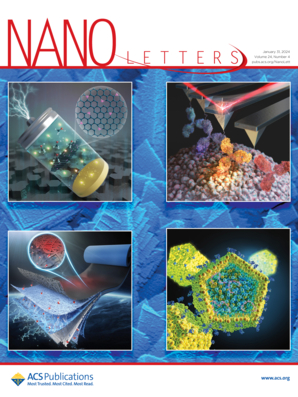晶体相工程使Al3+从纳米粘土中解放出来用于离子干扰肿瘤治疗。
IF 9.6
1区 材料科学
Q1 CHEMISTRY, MULTIDISCIPLINARY
引用次数: 0
摘要
离子干扰疗法(IIT)通过破坏细胞内离子稳态而成为一种很有前途的抗肿瘤策略。然而,平衡生理离子稳定性与肿瘤反应性离子释放仍然是一个关键的挑战。在此,我们提出了一种晶体相工程方法来编程具有热响应晶格应变的蒙脱土纳米粘土,从而使肿瘤微环境(TME)触发的晶体相铝(Al)释放成为可能。高温引起的晶格畸变使表面Al- oh密度增加了1.7倍,促进了酸性TME中ph响应型晶体相Al的释放。系统研究表明,工程纳米粘土在保持生理稳定性的同时,实现了87.5%的肿瘤选择性晶体相Al释放(增加了70%),通过与膜磷脂相互作用破坏肿瘤细胞膜,从而加速细胞内摄取。此外,细胞内晶体相Al的释放通过氧化应激导致线粒体功能障碍,最终诱导肿瘤细胞死亡并唤醒全身免疫反应。这项工作开创了纳米粘土治疗中晶体相位调制的先河,为空间控制离子干扰剂的发展提供了路线图。本文章由计算机程序翻译,如有差异,请以英文原文为准。
Crystal-Phase Engineering Enables Al3+ Liberation from Nanoclay for Ion Interference Tumor Therapy.
Ion interference therapy (IIT) has emerged as a promising antitumor strategy by disrupting intracellular ion homeostasis. However, balancing physiological ion stability with tumor-responsive ion release remains a critical challenge. Herein, we present a crystal-phase engineering approach to program montmorillonite nanoclay with thermally responsive lattice strain, which enables tumor microenvironment (TME)-triggered crystal-phase aluminum (Al) liberation. Hyperthermia-induced lattice distortion amplifies the surface Al-OH density by 1.7-fold, promoting pH-responsive crystal-phase Al liberation in the acidic TME. Systematic investigations reveal that the engineered nanoclay maintains physiological stability while achieving 87.5% tumor-selective crystal-phase Al liberation (increased by 70%), which destroys tumor cell membranes by interacting with membrane phospholipids, thereby accelerating intracellular uptake. Furthermore, the intracellular liberation of crystal-phase Al causes mitochondrial dysfunction through oxidative stress, ultimately inducing tumor cell death and awakening the systemic immune response. This work pioneers crystal-phase modulation in nanoclay-based therapeutics, providing a roadmap for the development of spatially controlled ion interference agents.
求助全文
通过发布文献求助,成功后即可免费获取论文全文。
去求助
来源期刊

Nano Letters
工程技术-材料科学:综合
CiteScore
16.80
自引率
2.80%
发文量
1182
审稿时长
1.4 months
期刊介绍:
Nano Letters serves as a dynamic platform for promptly disseminating original results in fundamental, applied, and emerging research across all facets of nanoscience and nanotechnology. A pivotal criterion for inclusion within Nano Letters is the convergence of at least two different areas or disciplines, ensuring a rich interdisciplinary scope. The journal is dedicated to fostering exploration in diverse areas, including:
- Experimental and theoretical findings on physical, chemical, and biological phenomena at the nanoscale
- Synthesis, characterization, and processing of organic, inorganic, polymer, and hybrid nanomaterials through physical, chemical, and biological methodologies
- Modeling and simulation of synthetic, assembly, and interaction processes
- Realization of integrated nanostructures and nano-engineered devices exhibiting advanced performance
- Applications of nanoscale materials in living and environmental systems
Nano Letters is committed to advancing and showcasing groundbreaking research that intersects various domains, fostering innovation and collaboration in the ever-evolving field of nanoscience and nanotechnology.
 求助内容:
求助内容: 应助结果提醒方式:
应助结果提醒方式:


